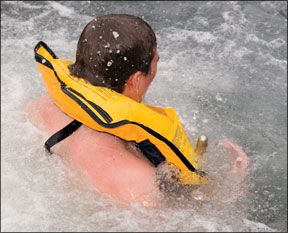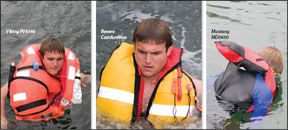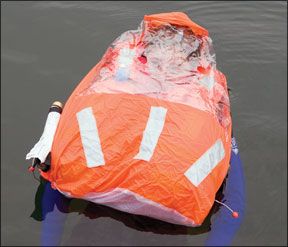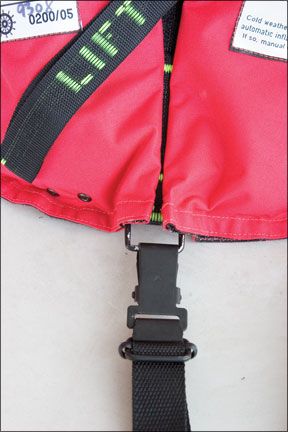
Since our last inflatable PFD test (Practical Sailor April 1, 2006), more products have hit the market. This time around, we review a variety from around the globe. Some are U.S. Coast Guard certified, and some are not. Some are inexpensive, and others are quite pricey. For a comparative baseline, we brought back one of the winners from past tests, the Crewsaver Crewfit 150N.
What We Tested
With proper maintenance, inflatable PFDs provide a comfortable and capable alternative to conventional foam life jackets. But maintenance is key. Foam will always float, but an inflation system is less reliable and requires proper care to work as intended. The inflation mechanisms and CO2 cartridges should be inspected regularly, and the PFDs should be cleaned and stored as directed by manufacturers.
Inflatable PFDs come in multiple sizes, shapes, and styles. For evaluation purposes, we split our test group into inflatable PFDs with and without a safety harness. While we prefer the PFD-harness combo, many sailors opt for a separate harness and PFD. This review will focus on the 10 inflatable PFDs we tested without harnesses. (Look for our evaluation of eight harness-PFD devices in a future issue.) Most test products feature both automatic and manual inflation capability; only two offer just manual deployment.
In the lineup are three offshore-class PFDs from European safety-gear maker Viking. From Canadian manufacturer Mustang Survival, we tested the new, vest-style MD0450. We also tested the vest that comes with the Float-Tech inflatable jacket; two ComfortMax PFDs from Revere, an American marine safety equipment maker; and a pair of lightweight West Marine PFDs (made by Stearns). Our reigning inflatable PFD winner, the Crewfit 150N from UK-based Crewsaver, rounded out the field.
Neither the Viking nor the Crewsaver PFDs are U.S. Coast Guard certified. The USCG certification process can be costly, so some manufacturers-particularly those in the European market-do not seek USCG certification even though their products meet the agencys set standards. These same products often carry certification by the UKs Maritime and Coastguard Agency (MCA).
How We Tested
Several testers, men and women, participated in the hands-on review and in-water testing of these inflatable PFDs. Each product was donned on land, and evaluated. Testers determined ease of donning based on the user-friendliness and security of the fasteners and straps and whether the strap stayed in place or slipped during use.
For in-water evaluation, testers donned the PFDs and jumped into a deep saltwater canal. We made sure the auto-activation function worked properly on those PFDs that had them. The entire automatic-deployment group operated properly and began to inflate the air bladder before testers bobbed to the waters surface. Testers activated the two manual vests after surfacing following the jump. Both of these deployed as expected.
In the water, with the vests inflated, testers rated each for comfort and fit. They attempted to swim face up and face down, and tested the PFDs ability to right an unconscious wearer by lying limp in the water face down. The oral inflator tubes, whistles, and lights were used on products that had them.
Finally, each PFD was rearmed and repacked, and given a rating based on the ease or difficulty of the task.
Additional testing included a spray test to determine whether accidental, automatic deployment could occur in heavy rain or sea spray. To do this, we put all of the test PFDs on deck and left them exposed to moderate rain for 30 minutes. The only PFD that inflated during the spray test was the Float-Tech vest, which is designed to be worn inside a jacket.
In our final analysis, testers also considered warranty, PFD buoyancy, safety features, and price.
Crewsaver
Crewsaver makes a variety of inflatable PFDs. We tested the Crewfit 150N, the winner of both the 2004 inflatable PFD test and the 2006 update. This device can be equipped with or without a harness D-ring or a crotch strap and is available in manual or auto/manual.
We once again found that the Crewfit fit well both on land and in the water. It earned Good ratings on land and the only Excellent in-water rating. The plastic snap-lock buckle with metal tension adjustment on the 150N was easy to use on land and in the water.

Testers found the Crewfit 150N to be the most comfortable in the water because it had the most room around the wearers chin, neck, and face. They did note that during inflation, all the PFDs tended to ride up toward the wearers face. This required the wearer to make some adjustments to the fit in the water once the air bladder had completely inflated. The waist belt on the 150N can be adjusted easily in the water with the vest inflated. A lifting handle is located between the bladder and cover on this vest. One drawback testers noted was that the Crewsaver lacks a way to inspect the CO2 inflation system.
Testers found re-arming/repacking the Crewfit to be straightforward and easy: Deflate using the inflator/deflator tube, unscrew the automatic trigger and replace with a new one, unscrew the CO2 cylinder and replace it with a new one, then repack it by folding and fastening the Velcro.
This vest is not USCG certified, though it is a top-quality product certified to European standards. It carries a three-year warranty.
Bottom Line: An excellent, middleweight inflatable PFD with limited availability in the U.S.
Float-Tech
Float-Tech Inc., a six-year-old company that grew out of a university class assignment, has a variety of safety apparel projects in the works. The Float-Tech PFD vest we tested is supplied as part of a float coat (jacket/PFD combo) that is normally worn together. (The Float-Tech was a Recommended product in our February 2007 review of six float coats.)
All testers, including the women testers, found the Float-Tech to be lightweight and comfortable on land and in the water. The waistband is 1 inch wide and uses an adjustable, plastic snap lock. A non-adjustable chest buckle offers added security.
Meant to be worn inside a jacket, the Float-Tech vest does not have a light, or whistle. Testers noted that the PFD had less buoyancy compared to some of the other vests that use larger air bladders and CO2 cylinders. Even with the Float-Tech vest inflated, a tester was able to dive underwater, and the vest was slow to roll over the simulated unconscious wearer. Another drawback was that it inflated after sitting in the rain for about 10 minutes during our spray test. But its higher sensitivity to water may be due to the fact its intended to have an outer layer, i.e. the jacket.
With the Halkey-Roberts inflator, the Float-Tech vest is simple and easy to re-arm: Unscrew the inflator cylinder and cap, replace the bobbin, then screw the cap back on, and replace the cylinder. Thats it. There is no folding or fasteners to redo.
Bottom Line: The Float-Tech is comfortable and easy to repack. You can wear it alone or with the accompanying jacket in foul weather. We suggest adding reflective tape and other safety features when donning it sans the jacket.
Mustang MD0450
Mustang Survival has expanded its inflatable PFD lineup significantly in the last few years. We tested its new MD0450 vest, which features a hydrostatic inflator from Hammar designed to activate once it is submerged 4 inches in water. The vest-style PFD also features a reshaped air bladder that provides an increase in freeboard to keep the wearer farther above the waters surface.

The Mustang MD0450 has a wide waistband and smaller chest strap, which were easy to fit. Our testers really liked this vest once it was on and adjusted, rating it Excellent for comfort and fit on land.
In the water, the Mustang provided tons of flotation and kept our testers heads far above the water. The oddly shaped air bladder deployed a large section behind the wearers head. This bladder also has wide side wings that did not deploy automatically.
Mustang spokesman Rob McMahon explained, “…there may be some circumstances where they do not deploy or bust out of the zipper on their own. This can be due to colder weather, water conditions, etc. They will easily deploy fully if you give the zipper a gentle tug.”
Testers found rearming the Mustang to be complicated. Users must completely replace the inflator and special CO2 cylinder.
Bottom Line: Comfortable enough to wear during long hours at the helm, the Mustang 0450 is costly and so is its rearming kit.
Revere ComfortMax
Revere Survival Products is a Florida-based company that has been manufacturing and importing survival gear for more than 70 years. The companys ComfortMax series of inflatable PFDs is available with either manual (61018) or automatic (61019) inflation, in navy or red, and with or without a harness. We reviewed one manual and one automatic ComfortMax without a harness for this test. Both use Halkey-Roberts inflators coupled with 33-gram CO2 cylinders to provide 35 pounds of buoyancy.
Testers found both very comfortable on land. The wide strap over the shoulders and around the waist gives the user a secure feel. The waistband fastens with a large, plastic clip that locks together with a loud snap. Knurled metal pins inside a metal ring provide adjustment of the waistband on each side. Testers found this system extremely easy to adjust.
In the water, the ComfortMax vests provided more than adequate flotation. We rated the fit as Good. In-water fine-tuning was easily accomplished with waistband adjustments.
Re-arming/repacking a Revere ComfortMax PFD is about as easy as it gets. Good instructions are attached to the device where they are needed.
Both of these PFDs are USCG certified, and both have a water-activated light not found on any other lower-priced vest.
Bottom Line: Top ratings, a water-activated light, and good prices get both Revere ComfortMax PFDs Best Choice ratings.
Viking
The company that began in 1960 as Nordisk Gummibdsfabrik-now known as Viking Life Saving Equipment-is headquartered in Denmark and has manufacturing facilities in several other countries, where it makes safety gear for recreational, fishing, and commercial operators.
About 15 or so inflatable PFDs can be found on Vikings website. We tested three that meet the strict international SOLAS (Safety of Life at Sea) standards. The PV9346 and PV9344 vests both have more than 60 pounds of buoyancy thanks to large air bladders. To provide the system redundancy required by the SOLAS standards, these vests have dual inflators, one auto and one manual, each topped with a 60-gram CO2 cylinder.

The PV9308 provides 40 pounds of buoyancy using the same system with two 38-gram CO2 cylinders. All the Viking CO2 cylinders are covered in protective foam rubber. All vests also have a whistle, light, and lifting handle.
On land, testers found all the Viking vests bulky, heavy behind the neck, and not very comfortable. Also, the Viking vests we tested have a crotch strap with a metal locking clip that testers found difficult to adjust.
In the water, there was quite a disparity between the three Viking products. The PV9346 has an asymmetrically shaped air bladder that is much larger on one side than the other. The design helps roll over an unconscious wearer, which it easily did in our test. The problem was that testers found it very uncomfortable and rated it Poor for in-water comfort/fit.
The PV9344 and PV9308 use symmetrical air bladders and garnered Good in-water comfort/fit ratings from our testers. Testers really liked the added warmth provided by the spray hood on the PV9344.
Re-arming/repacking on the Vikings was a bear. The PV9344 was difficult to get everything back inside. The other two were not as hard to repack.
Bottom Line: They are heavy, expensive, and uncomfortable. However, testers like the extreme buoyancy and added security of dual inflators. We recommend the least beefy of the three, the PV9308, for those who insist on maximum buoyancy and redundant inflation systems.
West Marine
West Marine is the colossus of marine retailers and frequently markets rebranded products under its own name. Thats the case here: The two lightweight inflatable West Marine-brand PFDs we tested are actually made by Stearns Inc.
This pair is nearly identical in look and design. The only difference between them is the inflator system: One uses an automatic Halkey-Roberts inflator and the other is manual.
On land, testers rated these two Excellent for donning and comfort. They were the least bothersome to have on. Their weight-nearly half that of others tested-and easily adjustable waistband were big pluses. However, they don’t offer nearly as much buoyancy as some of the other PFDs tested-they barely meet Coast Guard minimums for buoyancy, and they are approved Type V devices. Neither has a whistle, light, or reflective tape. Both were easy to rearm and repack.
All West Marine products are covered by the companys No Hassle Guarantee, which states “If you are ever dissatisfied with your purchase, simply return it. Well replace the item, or issue company credit.”
Bottom Line: These PFDs got top marks for comfort-and we all know that the PFD that works best is the one a sailor will actually wear. Though we prefer higher buoyancy numbers, the West Marine PFDs are the lightest of the bunch. Theyre worth considering, particularly for those in tropical climes where heavy or bulky safety equipment is more likely to go unused.
Conclusion
Our previous inflatable PFD winner, the Crewsaver Crewfit 150N, is still a tester favorite. However, wed like to see a means to quickly check the status of the inflation system.
A comparably priced alternative with even higher overall ratings and some added features is the Revere ComfortMax 61019. This vest is our Best Choice for automatically inflatable vests this time. The manual Revere ComfortMax 61018 gets the top pick for manual PFDs.
For those who find themselves in remote areas, we recommend the Viking PV9308. This beefy PFD meets strict SOLAS standards with dual inflation cylinders and added safety features.


































